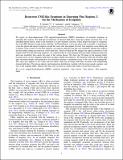Files in this item
Recurrent CME-like eruptions in emerging flux regions. I. On the mechanism of eruptions
Item metadata
| dc.contributor.author | Syntelis, P. | |
| dc.contributor.author | Archontis, V. | |
| dc.contributor.author | Tsinganos, K. | |
| dc.date.accessioned | 2018-08-15T14:30:08Z | |
| dc.date.available | 2018-08-15T14:30:08Z | |
| dc.date.issued | 2017-11-21 | |
| dc.identifier | 255392308 | |
| dc.identifier | 65ed2e0d-611c-4874-8d6d-8ced2e75acf8 | |
| dc.identifier | 85037686964 | |
| dc.identifier | 000415950200007 | |
| dc.identifier.citation | Syntelis , P , Archontis , V & Tsinganos , K 2017 , ' Recurrent CME-like eruptions in emerging flux regions. I. On the mechanism of eruptions ' , Astrophysical Journal , vol. 850 , no. 1 , 95 . https://doi.org/10.3847/1538-4357/aa9612 | en |
| dc.identifier.issn | 0004-637X | |
| dc.identifier.other | BibCode: 2017ApJ...850...95S | |
| dc.identifier.other | ORCID: /0000-0002-6926-8676/work/73700855 | |
| dc.identifier.other | ORCID: /0000-0002-6377-0243/work/77131782 | |
| dc.identifier.uri | https://hdl.handle.net/10023/15825 | |
| dc.description | This project has received funding from the Science and Technology Facilities Council (UK) through the consolidated grant ST/N000609/1. This research has been co-financed by the European Union (European Social Fund—ESF) and Greek national funds through the Operational Program “Education and Lifelong Learning” of the National Strategic Reference Framework (NSRF)—Research Funding Program: Thales Investing in Knowledge Society through the European Social Fund. The authors acknowledge support by the Royal Society. | en |
| dc.description.abstract | We report on three-dimensional (3D) magnetohydrodynamic (MHD) simulations of recurrent eruptions in emerging flux regions. We find that reconnection of sheared field lines, along the polarity inversion line of an emerging bipolar region, leads to the formation of a new magnetic structure, which adopts the shape of a magnetic flux rope (FR) during its rising motion. Initially, the FR undergoes a slow-rise phase and, eventually, it experiences a fast-rise phase and ejective eruption toward the outer solar atmosphere. In total, four eruptions occur during the evolution of the system. For the first eruption, our analysis indicates that the torus instability initiates the eruption and that tether-cutting reconnection of the field lines, which envelop the FR, triggers the rapid acceleration of the eruptive field. For the following eruptions, we conjecture that it is the interplay between tether-cutting reconnection and torus instability that causes the onset of the various phases. We show the 3D shape of the erupting fields, focusing more on how magnetic field lines reconnect during the eruptions. We find that when the envelope field lines reconnect mainly with themselves, hot and dense plasma is transferred closer to the core of the erupting FR. The same area appears to be cooler and less dense when the envelope field lines reconnect with neighboring sheared field lines. The plasma density and temperature distribution, together with the rising speeds, energies, and size of the erupting fields, indicate that they may account for small-scale (mini) coronal mass ejections. | |
| dc.format.extent | 15 | |
| dc.format.extent | 5048286 | |
| dc.language.iso | eng | |
| dc.relation.ispartof | Astrophysical Journal | en |
| dc.subject | Magnetohydrodynamics: MHD | en |
| dc.subject | Methods: numerical | en |
| dc.subject | Sun: activity | en |
| dc.subject | Sun: interior | en |
| dc.subject | Sun: magnetic fields | en |
| dc.subject | QB Astronomy | en |
| dc.subject | QC Physics | en |
| dc.subject | 3rd-NDAS | en |
| dc.subject.lcc | QB | en |
| dc.subject.lcc | QC | en |
| dc.title | Recurrent CME-like eruptions in emerging flux regions. I. On the mechanism of eruptions | en |
| dc.type | Journal article | en |
| dc.contributor.sponsor | Science & Technology Facilities Council | en |
| dc.contributor.institution | University of St Andrews. Applied Mathematics | en |
| dc.identifier.doi | 10.3847/1538-4357/aa9612 | |
| dc.description.status | Peer reviewed | en |
| dc.identifier.url | https://arxiv.org/abs/1711.10249 | en |
| dc.identifier.grantnumber | ST/N000609/1 | en |
This item appears in the following Collection(s)
Items in the St Andrews Research Repository are protected by copyright, with all rights reserved, unless otherwise indicated.

